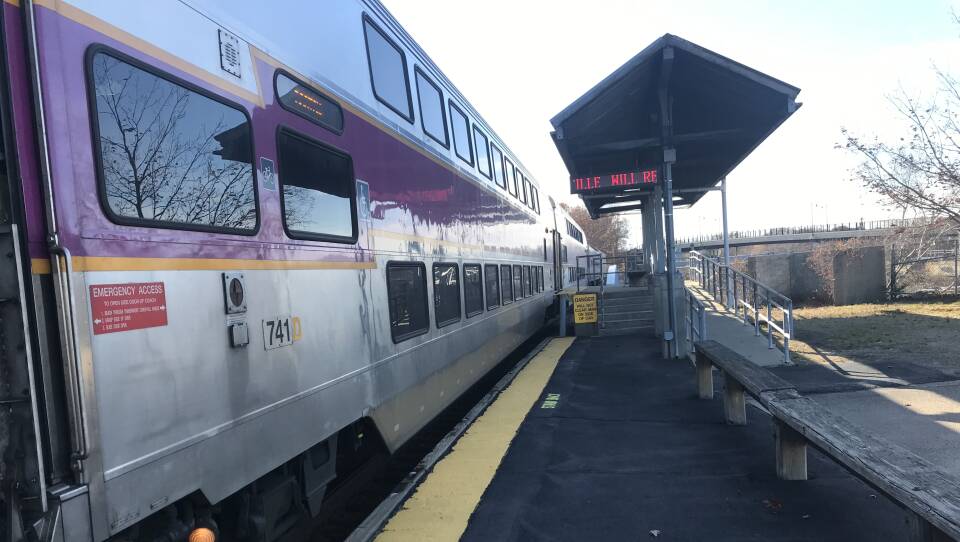The Fairmount commuter rail line, at a total of nine miles long, may be the shortest in the MBTA system, but its history is long and complicated. It’s the story of how mass transit can pass by the people who need it the most.
The line runs southwest from South Station through the low income and working class neighborhoods of Roxbury, Dorchester, Mattapan and Hyde Park, ending in Readville. It was used as a shuttle line for trains when the southwest corridor was being built in the 1980s to accommodate Amtrak service and was going to be abandoned, but community activists, along with the Conservation Law Foundation, successfully sued the state to preserve it and develop mass transit service along the corridor as an alternative to polluting buses.
Community activists wanted service that was more like rapid transit than commuter rail, with increased frequency and number of stops. However, the MBTA did not increase service frequency to match rapid transit lines, scheduling instead just one train per hour. Low ridership and cost were cited as reasons.
Two hundred million dollars was invested in renovating existing stations and adding three new ones beginning in 2012. Ridership more than tripled between that year and 2016, from about 700 people per day to 2,300, still the lowest ridership on the commuter rail system.
Community activists like Mela Bush of the Greater Four Corners Action Coalition contend that if the line were run more like the MBTA’s subways and trolleys, more frequent service would boost ridership. Bush said the Indigo Line name was chosen to be part of the T's Red, Orange, Green and Blue rapid transit system. But commuter rail is what they have.
Bush said fares are another issue. Although they have been reduced to $2.25 to match the T’s other rapid transit fares, because it is a commuter rail and fares are based on mileage, that last stop in Readville is in another zone, boosting its ticket price to $6.25. Bush said this is a big deterrent to those who would use it.
Those who do use the Fairmount line to commute, some riders told WGBH News, said it has gotten busier in recent years and having more trains makes sense.
Mayor Marty Walsh’s administration agrees. Chief of Transportation Chris Osgood said the density of population along the line justifies rapid transit service, but that’s the long-range plan. The costs of the new equipment required are prohibitive. For the immediate future, Osgood said the city is working with the MBTA to try and use existing equipment to increase the frequency of service to every 45 minutes, perhaps every half hour at peak demand times, but not the 10 to 15 minute intervals transit activists were hoping to see.
The station improvements along the Fairmount line have brought with them other problems.
“Now that we have the stations that are coming in, we're already seeing a spike in rental increases, in evictions and housing prices,” said Allentza Michel, an urban planner and policy advocate.
Michel said the city must do more to protect residents where transit service is improved, like requiring developers to provide more affordable housing.
Walsh this month presided over the opening of the Residences at Fairmount Station apartments, where 24 of 27 rental units are marketed as affordable. He said the development is proof that such displacement is not inevitable.
“Not if you do it right, planning it out, not just plopping buildings in places and businesses," Walsh said. "It's about planning out what you want to see there, and the coalitions that advocated for the Fairmount line understand that “
But Michel said the city could do more by changing its development policy to require 30 percent affordable housing units, up from the current 13 percent.
The mayor's chief of housing, Sheila Dillon, said it's a difficult balancing act.
"This is sort of the million dollar question these days, right?" Dillon said. "As we improve transportation, as we improve the commercial areas, how do we make sure the people who made it great aren't pushed out?”
Dillon said without rent control, which Massachusetts voters rejected in 1994, the only answer is to build more affordable housing. Dillon said often vacant land can be found around transit stations and developed, like what was done at the Fairmount station. But it took 20 years for the project to be completed after much opposition, most of it from local residents. Now, though, residents can see how attractive the housing is and how well its fits into their neighborhood, Dillon said.
Complicating the controversy over the Fairmount line is New England Patriots owner Robert Kraft's proposal to use the tracks to extend commuter rail service to Foxborough. He has agreed to subsidize the service by providing 500 spaces for commuters at Gillette Stadium. Last week, Foxborough selectmen approved the service to begin next May.
That worries inner city advocates like Mela Bush, who fears the new commuter trains will take over the tracks they want for rapid transit, a fight they have been waging for 20 years. Bush said she can’t help but feel that the reason they have been ignored has to do with the communities the Fairmount line travels through.
“The majority are low income and people of color [who] live along that line, and this should not be in 2018," Bush said. "We need something better, and we need it now."





